Standard reports reference
A complete list of all the standard report types with details on each type.
Standard reports are report types that are available in all MobiClocks environments by default. Standard reports address the most common reporting use cases in the construction industry. If you need a report type that is not included here, please contact us.
This topic is a list of all the standard report types with details on each type. Each entry in the list includes the following information:
- Report name
- Available formats. The file formats that you can download the report in.
- Date range. The date range that can be selected for the report. Some report types let you generate data for any custom period, and there are also weekly and daily reports.
- Overview. A brief overview of the report and the data it includes.
- Fields included. The list of the fields included in the report.
- Example. A screenshot of an example report.
Employee Missed Punch
Available formats: PDF, XLSX, CSV
Date range: Custom
The report collects all the instances of missed punches for the selected period. Missed punches refer to the timelogs that have been flagged as a missed punch. For more information on the missed punch flag, see Flag types.
The report also includes the timelogs where the entry has been added manually, which is also considered a missed punch. In this case, the punch in and punch out times are not indicated.
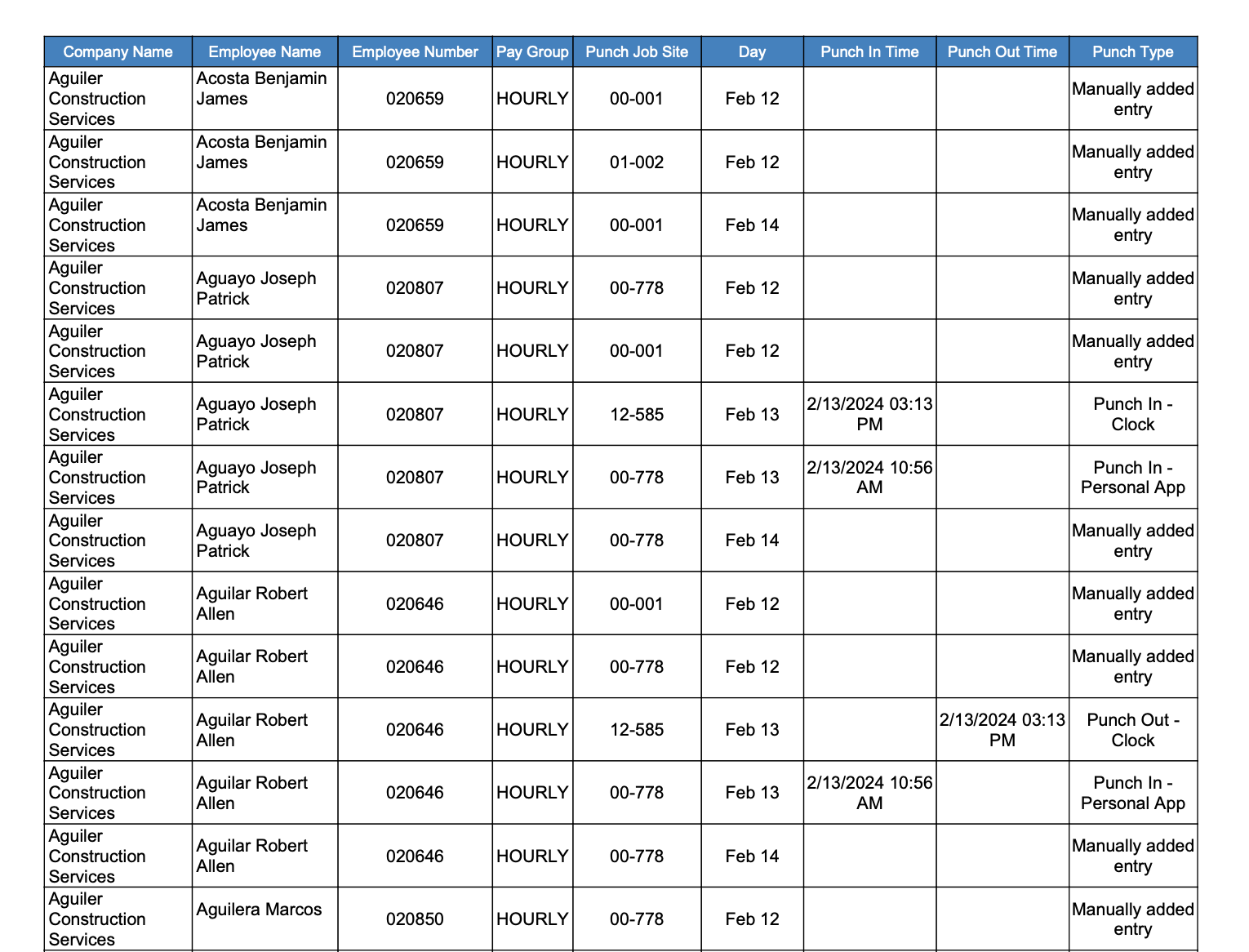
Employee Missed Punch report example
The report includes the following fields:
- Company Name. The name of the employee's company.
- Employee Name. The full name of the employee.
- Employee Number. Employee's identification number.
- Pay Group. Employee's pay group.
- Punch Job Site. The job site where the timelog has been recorded.
- Day. The date when the timelog was recorded.
- Punch In Time. The time of the punch in if there has been any.
- Punch Out Time The time of the punch out if there has been any.
- Punch Type. Indicates if the punch has been made through the Personal App (
Personal App), Kiosk App (Clock), or added manually (Manually added entry).
Employee Roster
Available formats: PDF, XLSX, CSV
Date range: Daily
The Employee Roster report shows the list of employees for a selected company. The report can only be generated for a specific day and not a date range.
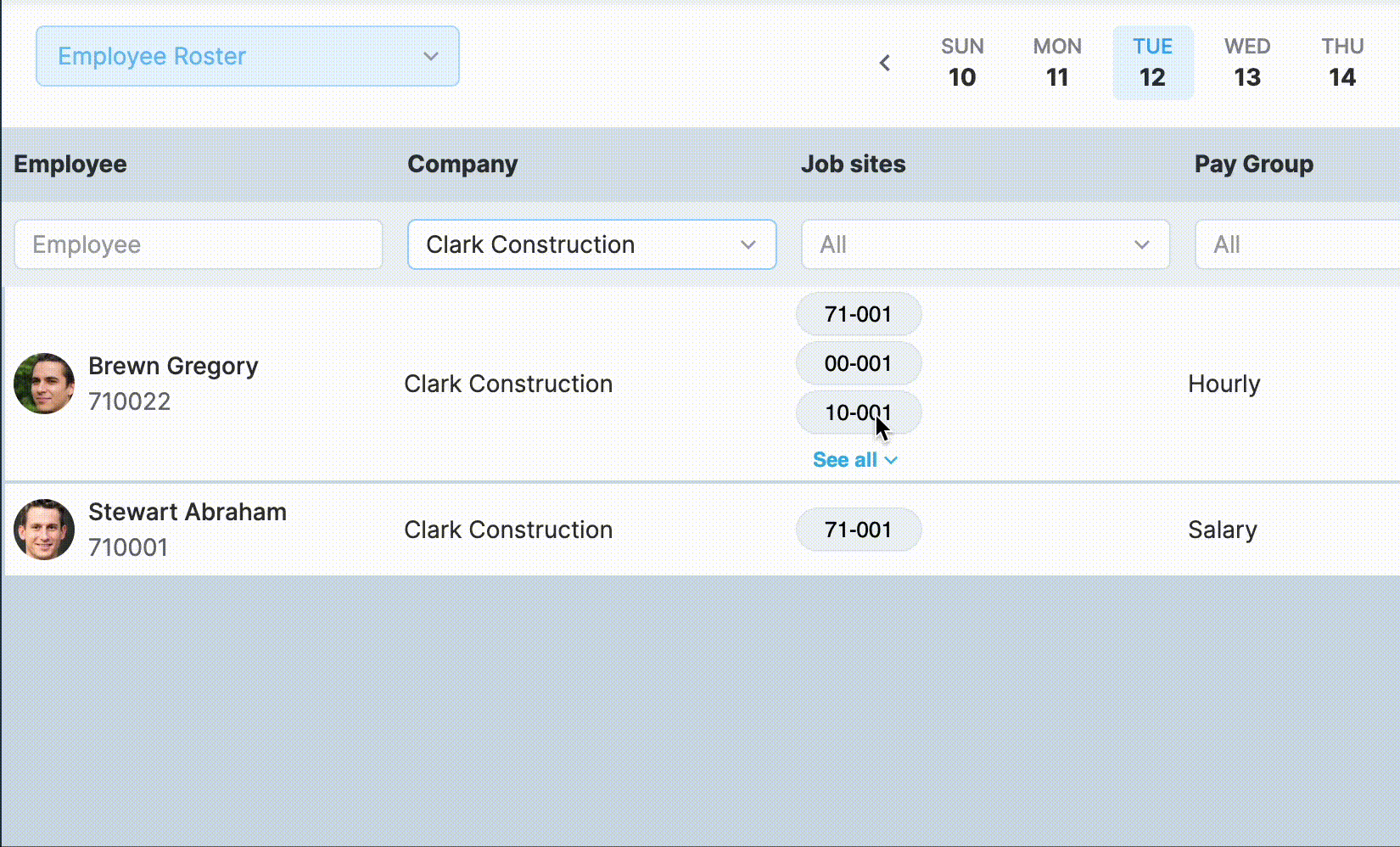
Viewing the list of employees for different companies
The report contains the following fields:
- Company. The name of the selected company.
- Employee name
- Employee Number. The employee number
- Employee Job Site(s). The job sites that the employee is assigned to.
- Pay Group. Employee's pay group.
- Job Title. Employee's job title.
- Hourly Rate. Employee's regular pay rate.
Employee Time Card
Available formats: PDF, XLSX, CSV
Date range: Weekly
The Employee Time Card report provides a list of each employee's timelogs for the selected period. The following screenshot shows an example of the report page for a specific employee, but the report can include multiple pages depending on the number of employees that have timelogs for the selected period.

Employee Time Card report example
The report includes the following fields:
- Day. The day of the week.
- Date
- In. Punch in time.
- Out. Punch out time.
- Job Site. The name of the job site where the employee has worked.
- PayID. The pay ID of the timelog.
- Hours. How many hours the employee has logged.
At the end of each day, you also have a Daily Total and Per Diem rows that show the total time the employee has worked during the day as well as the per diem allowance if any.
Lastly, since the Employee Time Card report is usually handed to employees to review and confirm, the report also includes a signature text, which can be customized in Administration () > Settings > General > Time Card Signature.
Hours Summary
Available formats: PDF, XLSX, CSV
Date range: Custom
The report includes the sum of hours each employee has worked on a particular job site as well as summarizes the total number of hours logged by all the employees. As shown in the following screenshot, the last row of the report is named Total and shows the sum of all the employee hours in the list.
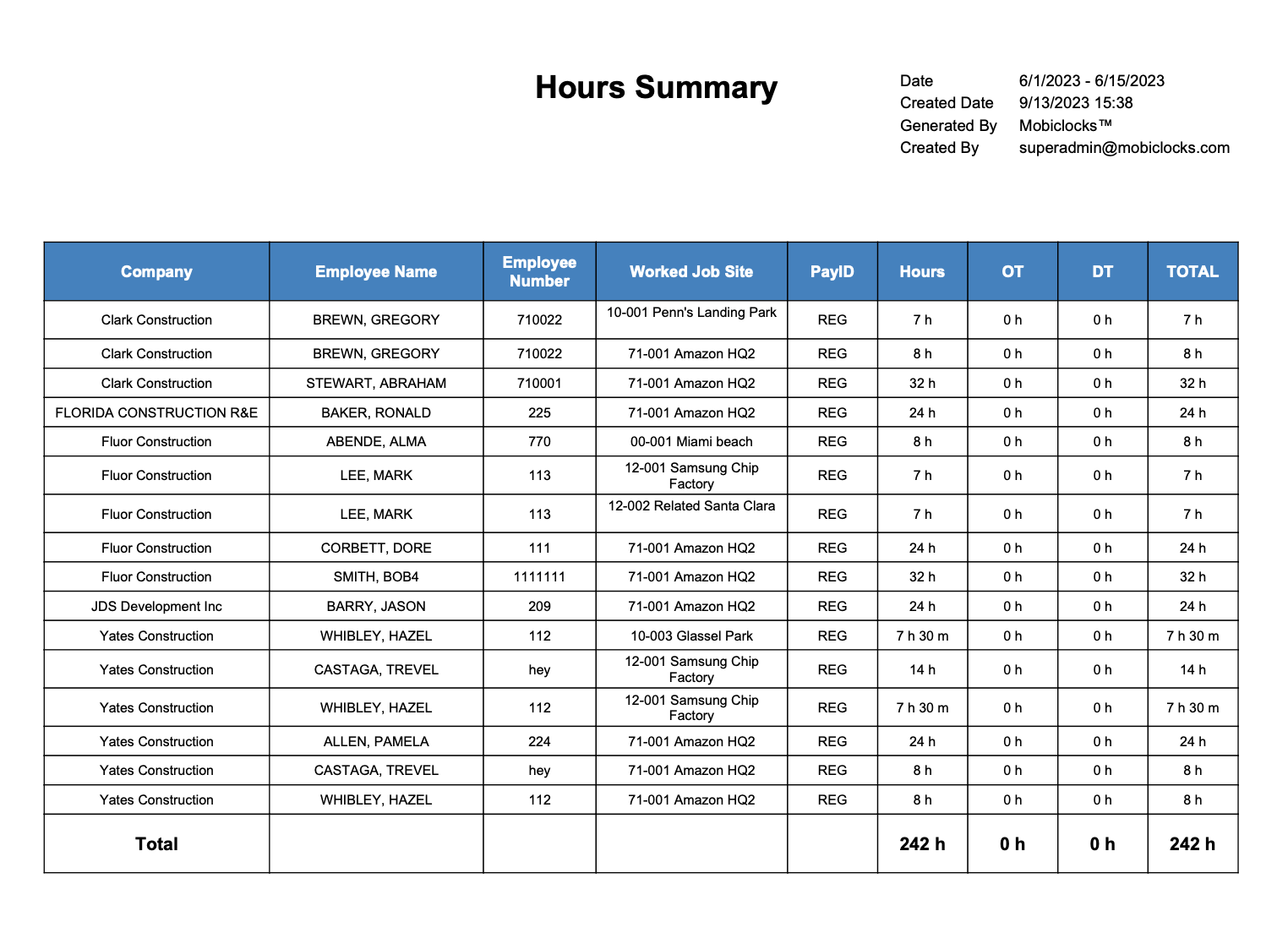
Hours Summary report example
The report includes the following fields:
- Company. Employee's company.
- Employee Name
- Employee Number. The employee number.
- Worked Job Site. The job site where the employee has worked at.
- PayID. The pay ID of the timelog.
- Hours. How many hours the employee has logged.
- OT.Overtime hours if any.
- DT.Double-timehours if any.
- TOTAL. The total number of hours logged by the employee.
Job Site Missed Punch Details
Available formats: XLSX
Date range: Custom
The report lists missed punches for each job site employee. In the downloaded XLSX file, each job site has a separate tab with the list of employees that have one or more missed punches.
The employee's timelog is qualified as a missed punch if it has been flagged as a missed punch or the timelog entry has been added manually. Each employee row can have one of the following three values assigned to it for each day of the selected period:
- Missed Punch In (A). The employee has punched out from the job site without having punched in prior to that. Therefore, the timelog has been flagged as a missed punch.
- Missed Punch Out (B). The employee hasn't punched out within 24 hours after punching in.
- Missed Both (C). The timelog entry has been added manually.

Job Site Missed Punch Details report example
Additionally, the report includes the following employee details:
- Employee ID. The employee number.
- Pay Group. Employee's pay group.
- Company. Employee's company.
Job Site Roster
Available formats: PDF, XLSX, CSV
Date range: Daily
For each job site, the report includes the list of employees who are assigned to the job site and shows if they have punched or not. Additionally, it includes the employees who are not assigned to the job site but have punched there.
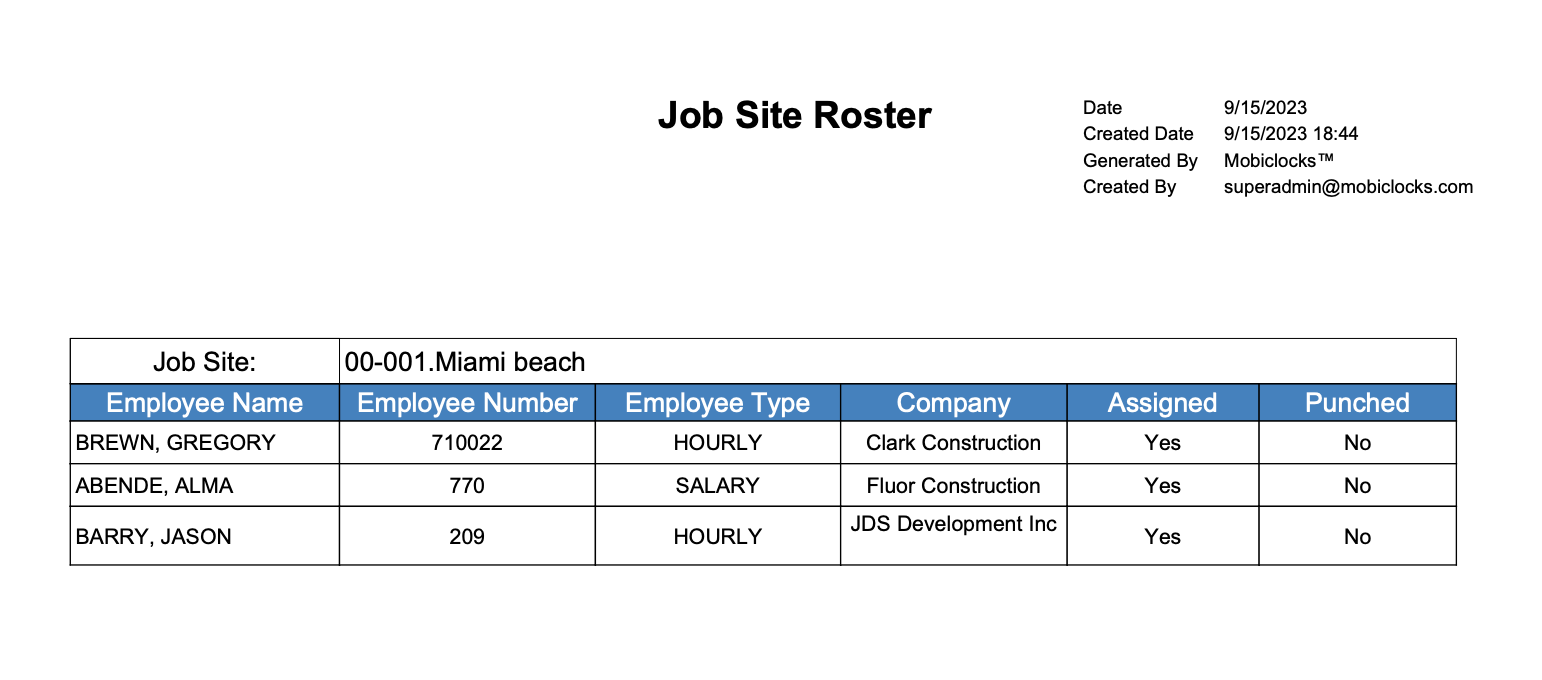
Job Site Roster report example
- Employee Name
- Employee Number. The employee number.
- Employee Type. Employee's pay group.
- Company. Employee's company.
- Assigned. Is the employee assigned to the job site.
- Punched. Has the employee punched on the job site on the selected day.
Labor Production
Available formats: PDF, XLSX, CSV
Date range: Custom
The report is generated for the selected job site, summarizing the total employee hours logged in the selected period for each of the job site's cost codes.
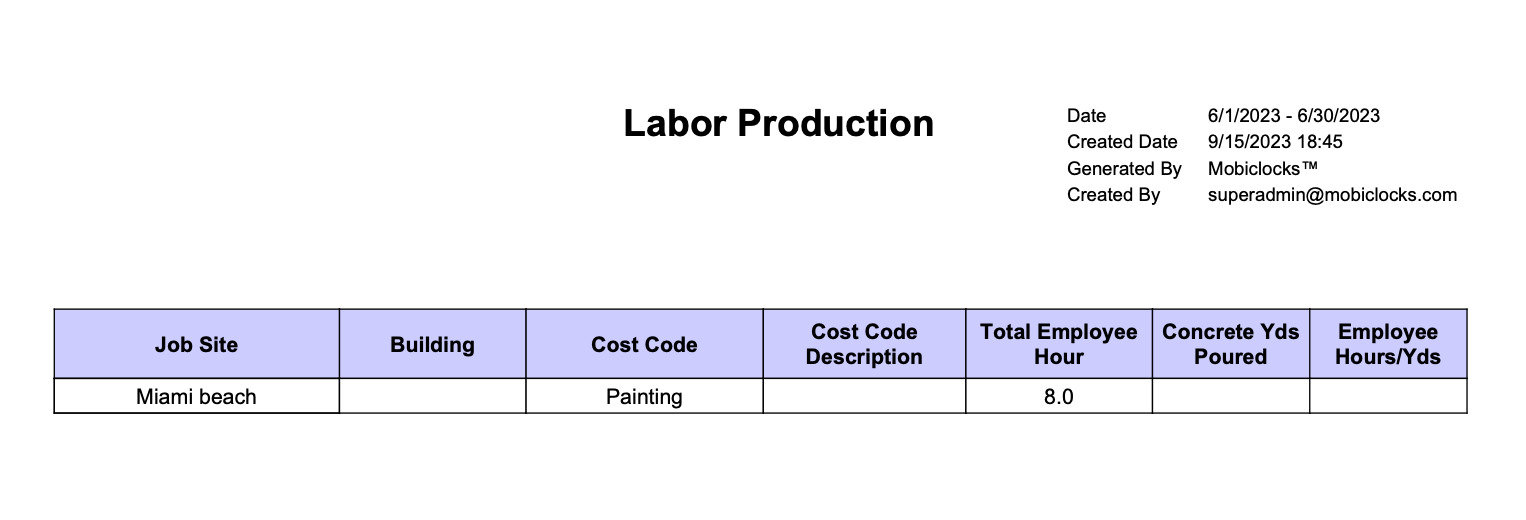
Labor Production report example
The following fields are included:
- Job Site. The name of the job site.
- Building. Job site building number if any.
- Cost Code. The cost code that has been applied to the accomplished work.
- Cost Code Description. The description of the cost codecode if any.
- Total Employee Hour. The number of hours logged by employees under the cost code.
New Hours Summary
Available formats: XLSX
Date range: Custom
The report summarizes how many hours each employee has worked on each job site. It provides a detailed breakdown for each day, including regular, overtime, and double-time hours, and also includes the total number of hours and how much the employee needs to be paid for the selected period.
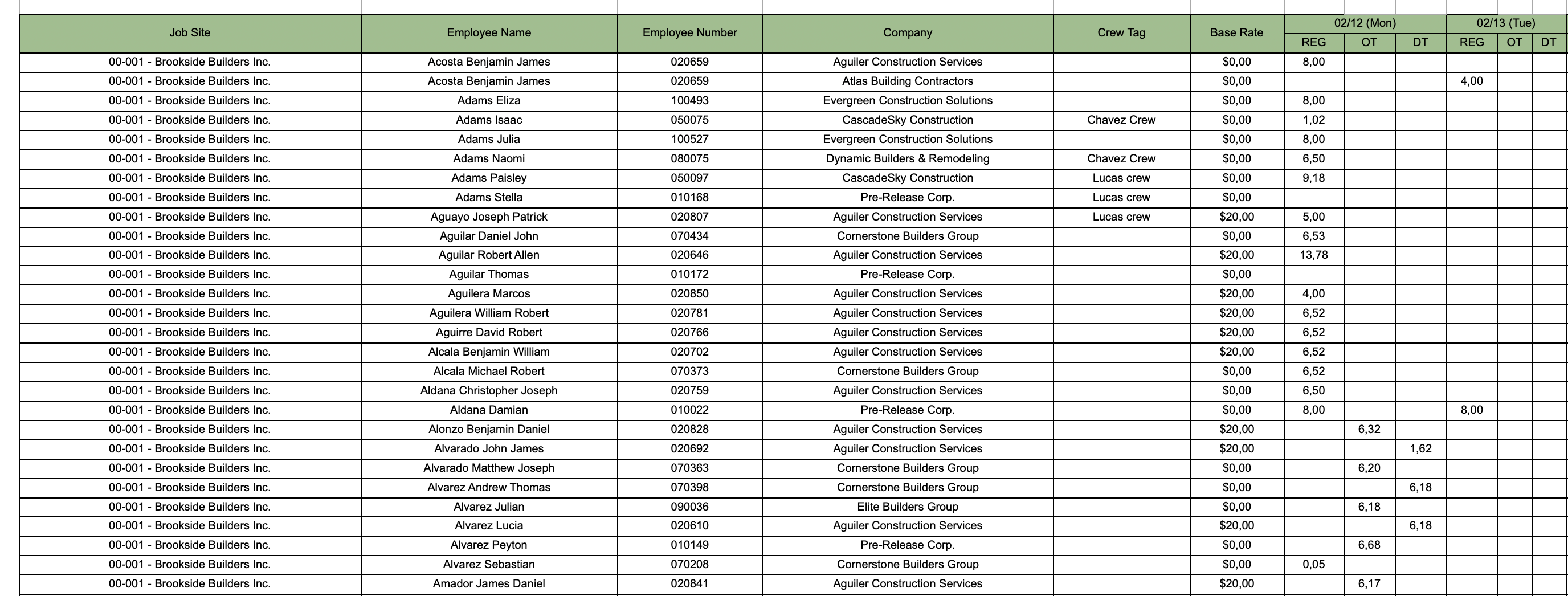
New Hours Summary report example
The report includes the following fields:
- Job Site. Employee's job site.
- Employee Name
- Employee Number. The employee number.
- Company. Employee's company.
- Crew Tag. The crew tag of the employee within the job site.
- Base rate. Employee's regular rate regular rate.
- REG. Regular hours worked on a particular day.
- OT. Overtime hours worked on a particular day.
- DT. Double-time hours worked on a particular day.
- Totatl REG. The total number of regular hours.
- Total OT. The total number of overtime hours.
- Total DT. The total number of double-time hours.
- Grand Total. The total number of hours worked. This isn't necessarily the sum of regular, overtime, and double-time hours, as the employee's work may fall under other pay ID as well.
- Total Pay. How much the employee must be paid.
New Missing Cost Codes
Available formats: PDF, XLSX, CSV
Date range: Custom
The report generates a list of all the timelogs that have not been cost coded.
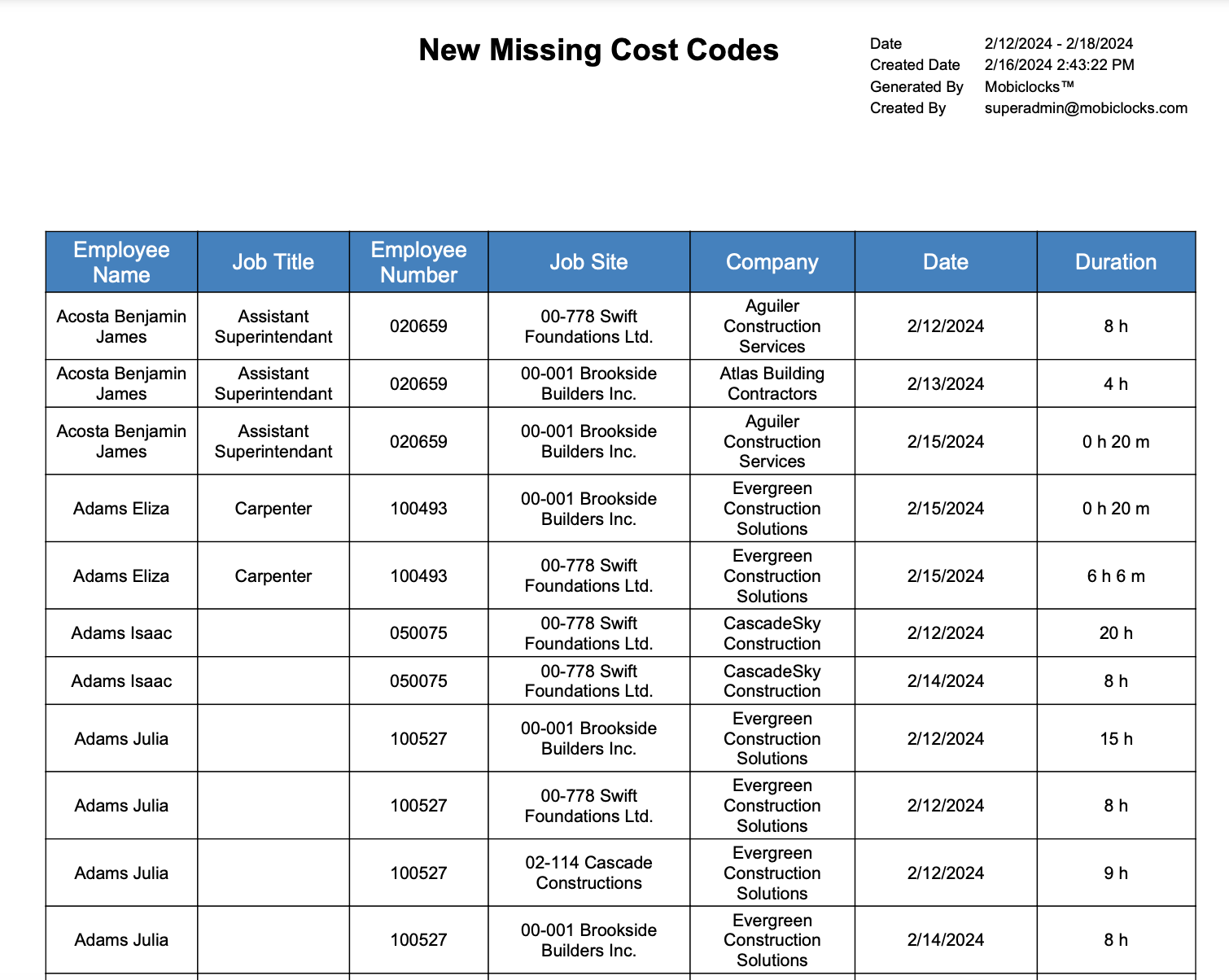
New MIssing Cost Codes report example
The following fields are included:
- Employee Name. The full name of the employee.
- Job title. Employee's job title.
- Employee Number. The employee number.
- Job Site. The name and number of the job site where the timelog has been recorded.
- Company. Employee's company.
- Date. The date of the timelog.
- Duration. The duration of the timelog.
Punch Details
Available formats: XLSX, CSV
Date range: Custom
The report includes details on each employee punch in or punch out for the selected company.

Punch details report example
The following fields are included:
- Company. The employee's company.
- Employee. Employee's name and employee number.
- Employee Job Site. Employee's main job site.
- Punch Job Site. The job site where the employee has punched.
- Clock. The clock of the punch.
- Punch Time. The time of the punch.
- Punch Type. Either
PUNCH_INorPUNCH_OUT. - Punch Status
Round Up Minutes
Available formats: PDF, XLSX, CSV
Date range: Custom
The report includes the total minutes worked by each employee during the selected period as well as how many minutes have been subtracted or added as a result of rounding down or up.
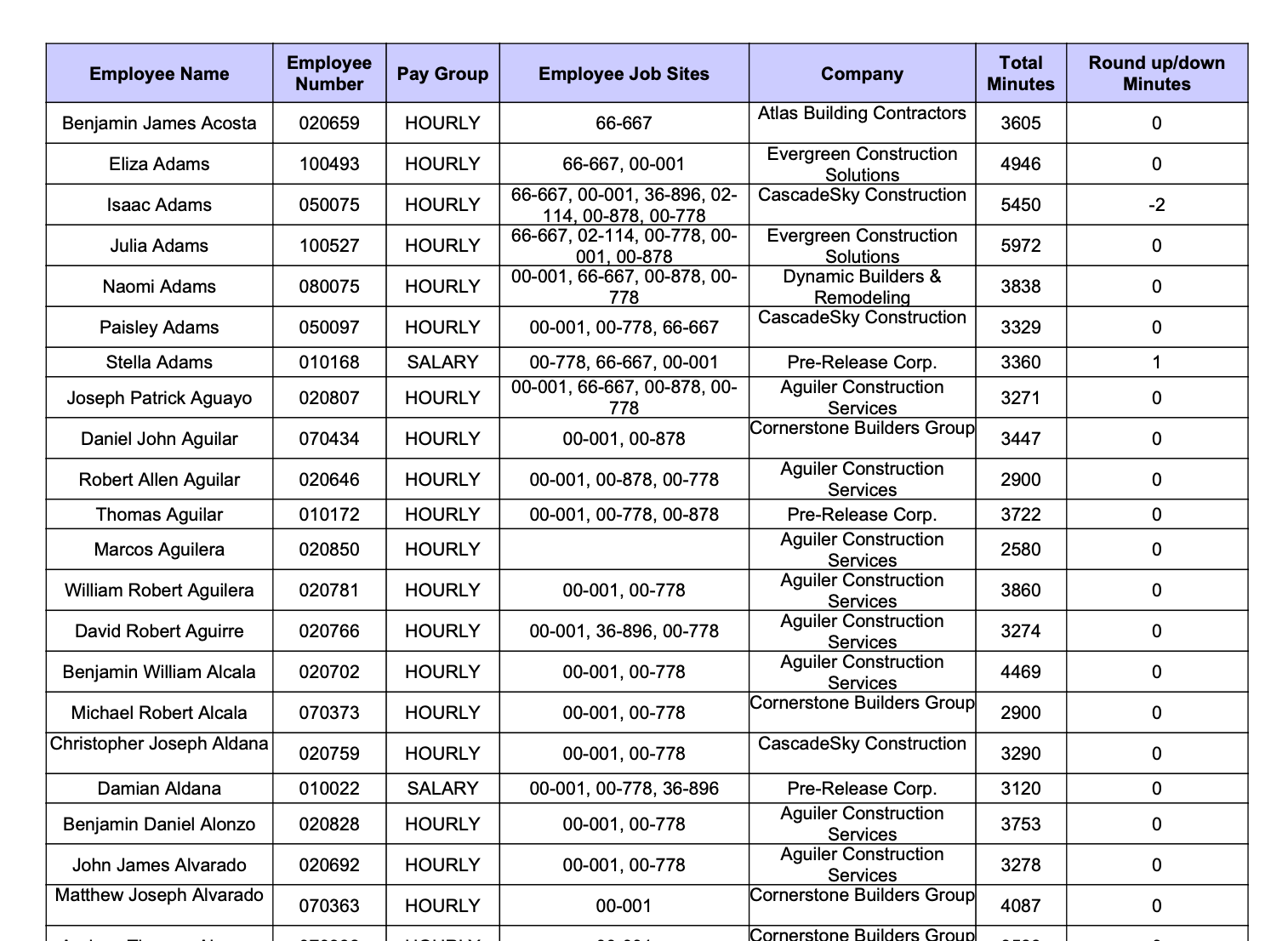
Round Up Minutes report example
The report includes the following fields:
- Employee Name
- Employee Number. Employee's number.
- Pay Group. Employee's pay group.
- Employee Job Sites. The job sites the employee has worked on.
- Company. Employee's company.
- Total minutes. The total number of minutes tracked by the employee.
- Round up/down Minutes. How many minutes have been added (positive numbers) or subtracted (negative numbers) from the total minutes as a result of rounding up or down.
Salary Actual Hours
Available formats: PDF
Date range: Weekly
In Timelogs, you see the daily default 8h for salary employees and not the actual hours tracked by them. This report gives a detailed overview of the time tracked by salary employees.
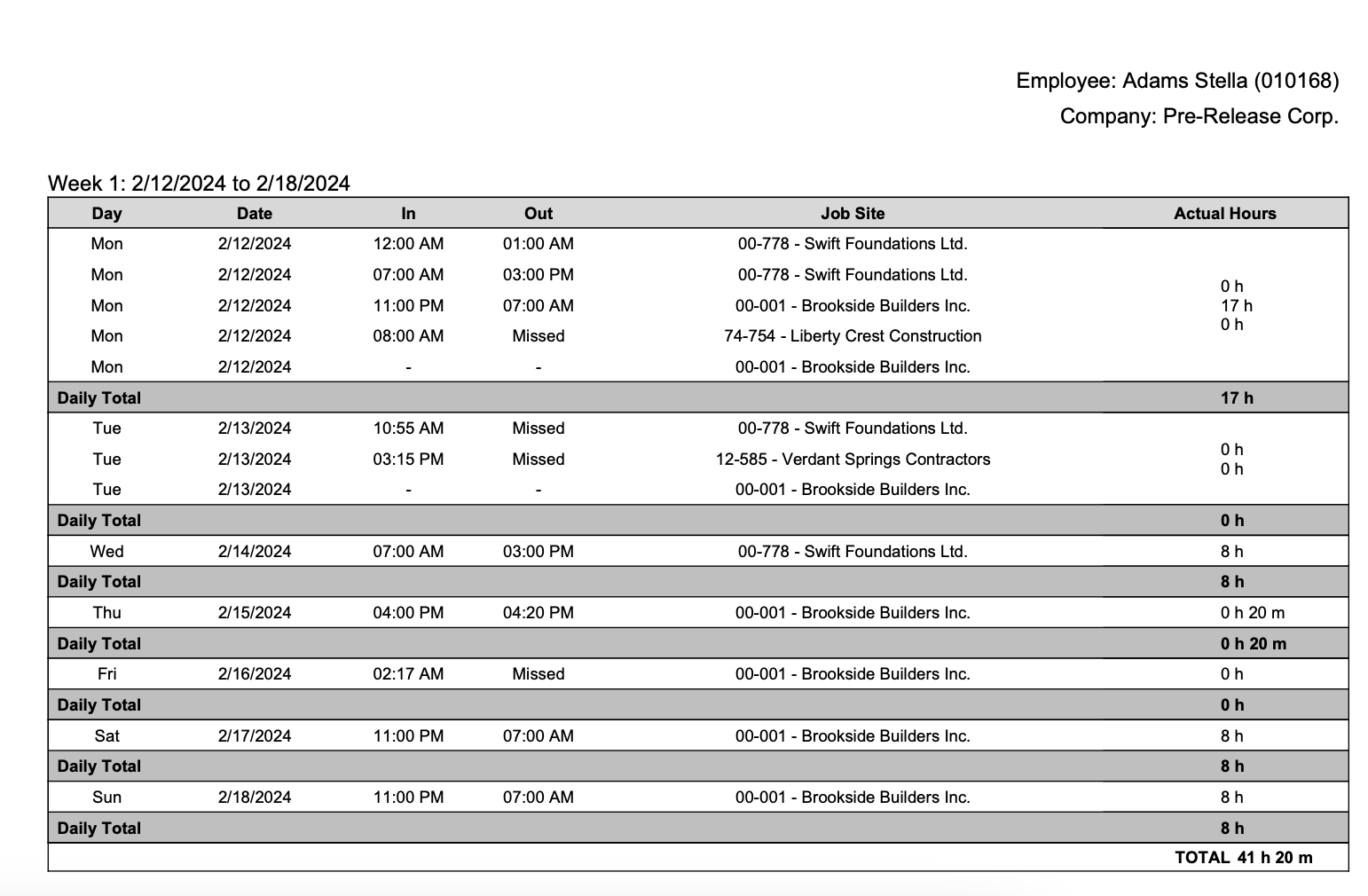
Salary Actual Hours report example
The following fields are included:
- Day. The day of the week.
- Date
- In. Punch in time.
- Out. Punch out time.
- Job Site. The job site where the employee has punched.
- Actual hours. The total number of hours tracked by the employee on that day.
Super Crew
Available formats: PDF
Date range: Daily
The report provides an overview of the work accomplished by the selected job site's crews.
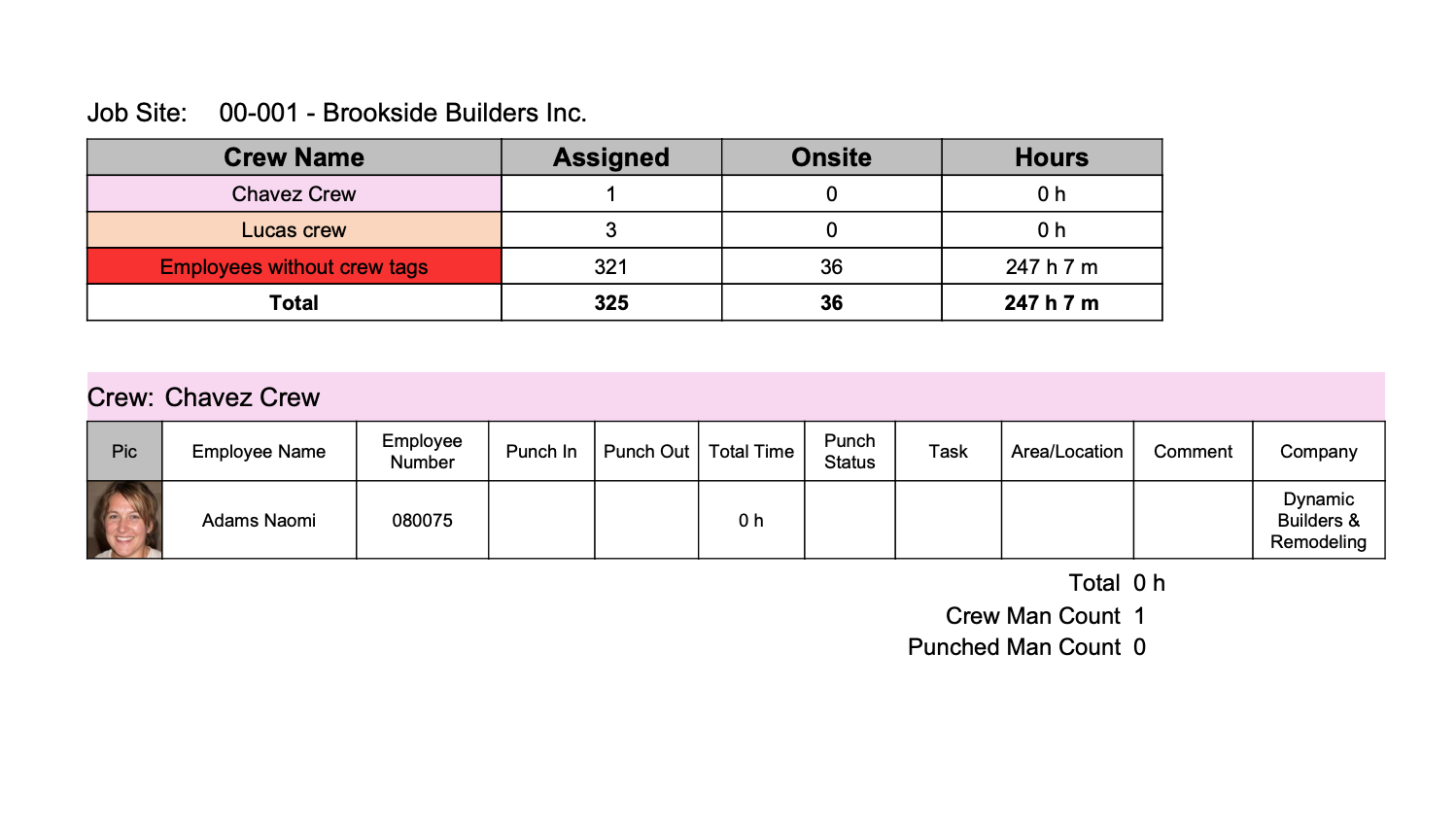
Super Crew report example
First, you have a high-level overview where you see how many employees are assigned to each crew and how many employees don't have a crew. Also, there is an Onsite field that shows how many employees have attended the job site on the selected date. Lastly, you have an Hours column that shows how many hours each crew has worked.
Next, you have a more detailed breakdown for each crew employee that includes the following fields:
- Pic. Employee's profile picture.
- Employee Name
- Employee Number. Employee's number.
- Punch In. Punch in time.
- Punch Out. Punch out time.
- Total time. How long has the employee worked.
- Punch Status. The following options are possible:
- Normal. The employee has punched in and out themselves.
- Manual Entry. The punch hours have been entered manually.
- Missed Punch. There's been a missed punch.
- Empty. The cell is empty, which means that the employee hasn't attended the job site.
- Company. Employee's company.
Time and Attendance
Available formats: XLSX, CSV
Date range: Custom
The report presents employee attendance details for the selected period. If the employee has worked on multiple job sites, there is a separate row for each job site. Additionally, if more than one cost code has been applied to the employee's work on a specific job site, the job site row is further broken down into multiple rows for each cost code.

Time and Attendance report example
The following fields are included:
- Crew Tag. The crew tag of the employee within the job site.
- Employee Number. Employee's employee number.
- Employee Name
- Pay Class. Pay class if any.
Timelog Edits
Available formats: XLSX, CSV
Date range: Custom
The report includes the timelogs that have been edited during the selected period.

Timelog Edits report example
The following fields are included:
- Employee Name. The name of the employees.
- Employee Number. The employee number.
- Job Site. The job site where the timelog has been recorded.
- Company. Employee's company.
- Original Punch-In Time. The original punch in time of the timelog.
- Modified Punch-In Time. The modified punch in time. If the punch in time hasn't been modified, the original punch in time is indicated.
- Original Punch-Out Time. The original punch out time of the timelog.
- Modified Punch-Out Time. The modified punch out time. If the punch in time hasn't been modified, the original punch out time is indicated.
- Modified By. The email of the user who has modified the timelog.
- Modified Date. The date when the timelog was modified.
- Time Change Difference. The difference between the new
Total Employee Count
Available formats: PDF, XLSX, CSV
Date range: Custom
The report shows how many employees have worked on each job site from a particular company. It also includes the number of hours worked on each job site.
The following screenshot shows an excerpt from an example report that includes data for the Aguiler Construction Services company. Next, you have the list of all the job sites in your environment and the number of employees involved from Aguiler Construction Services under Employee Count.

Total Employee Count report example
The following fields are included:
- Project name. The name of the job site.
- Project number. The number of the job site.
- Regular. Regular hours logged.
- OT.Overtime hours if any.
- DT.Double-timehours if any.
- Total. The total number of hours logged by the employee.
- Employee. The number of employees from the selected company that have worked on the job site.
Unresolved Flags
Available formats: PDF, XLSX, CSV
Date range: Custom
The report generates a list of all the unresolved flags for the selected period. Even if the same employee has multiple unresolved flags, each flag occupies a separate row.
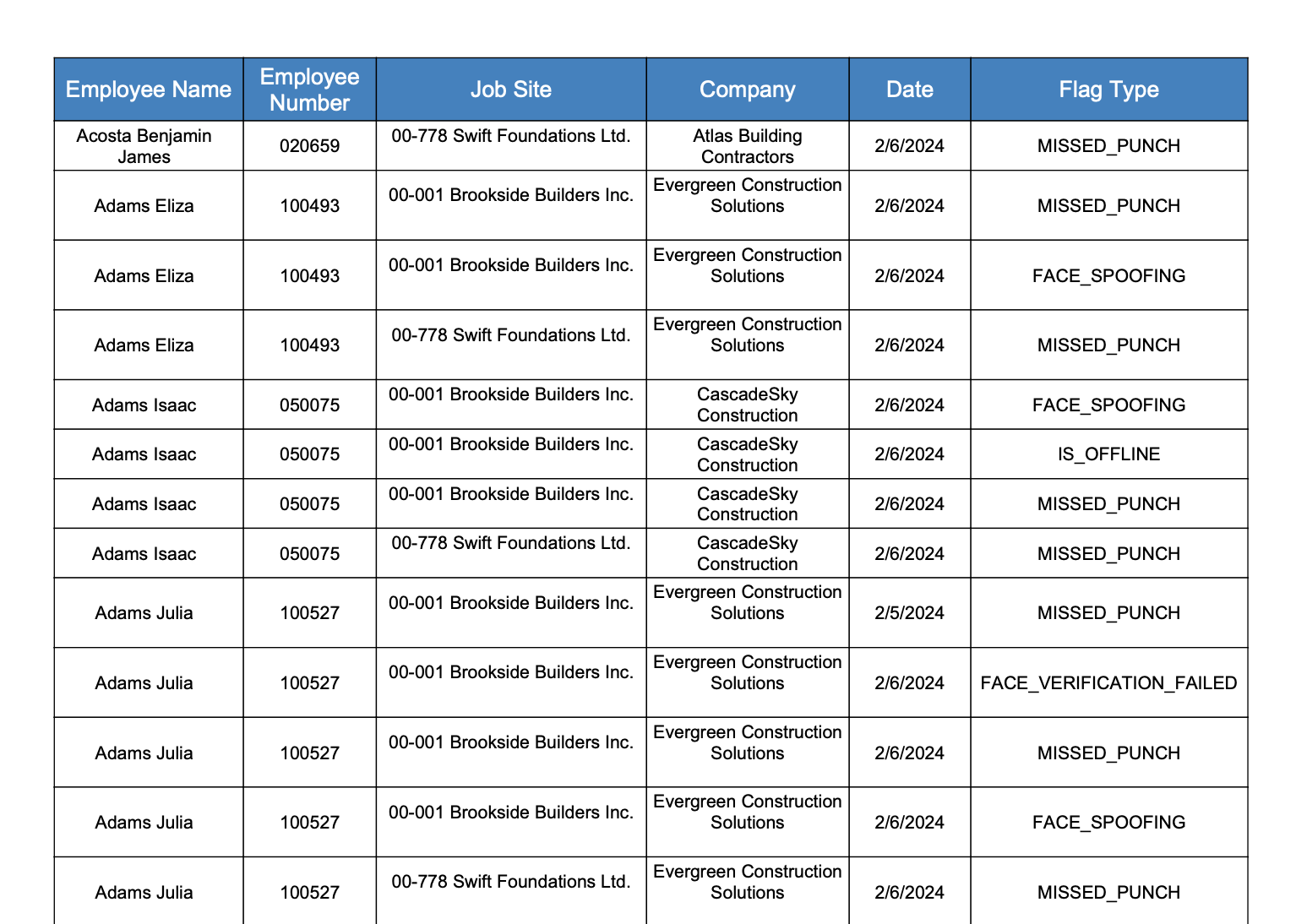
Unresolved Flags report example
The following fields are included:
- Employee Name. The full name of the employee.
- Employee Number. The employee number.
- Job Site. The name and number of the job sites where the timelog has been recorded.
- Company. Employee's company.
- Date. The date of the timelog.
- Flag Type. The type of the flag that has been left unresolved. For the full list of flag types, see Flag types.
Updated about 2 months ago